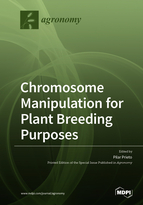Chromosome Manipulation for Plant Breeding Purposes
A special issue of Agronomy (ISSN 2073-4395). This special issue belongs to the section "Crop Breeding and Genetics".
Deadline for manuscript submissions: closed (20 July 2020) | Viewed by 35383
Special Issue Editor
Interests: plant breeding; meiosis; chromosome pairing; chromosome dynamics
Special Issues, Collections and Topics in MDPI journals
Special Issue Information
Dear Colleagues,
The ability to exploit the potential of wild relatives carrying beneficial traits is a major goal in breeding programs. However, it relies on the possibility of the chromosomes from the crop and the wild species in interspecific crosses to recognize, associate and undergo crossover formation during meiosis, the cellular process responsible for producing gametes with half the genetic content of the parent cells. Unfortunately, in most of the cases, a barrier exists preventing successful hybridization between the wild and the crop chromosomes. Understanding the mechanisms controlling chromosome associations during meiosis are of great interest in plant breeding. Thus, examining how chromosomes recognize, associate in pairs, synapse and recombine, which are prerequisites for the balanced segregation of half-bivalents during meiosis, will allow chromosome manipulation to introduce genetic variability from related species into a crop. In addition to interspecific hybrids, other materials, such as natural and synthetic polyploids and introgression lines derived from allopolyploids, among others, are powerful tools in the study of meiosis. For example, an extra pair of alien chromosomes in the full genome complement of a crop species has been frequently used as a first step to access genetic variation from the secondary gene pool in breeding programs. However, such introgression lines are also pivotal in the study of interspecific genetic interactions, in the chromosomal location of genetic markers and in the study of chromosome structure and behavior in somatic and meiotic cells.
This Special Issue invites original research, technology reports, methods, opinion, perspectives, reviews and mini reviews dissecting how chromosomes associate in pairs, recombine and segregate in the gametes during meiosis, with the aim of manipulating such processes and promoting non-homologous recombination in the framework of plant breeding. In addition, the development of new aneuploid lines and interspecific hybrids; new methods to identify, isolate and manipulate single chromosomes; improved genomic in situ hybridization techniques to identify new chromosome organizations and specific meiotic events; chromosome engineering protocols to detect critical recombinants, etc. will be considered within the general scope of this Special Issue.
We strongly believe that this compilation of high quality scientific papers shedding light on the key processes involved in chromosome associations during meiosis will enable a better understanding of chromosome manipulation for plant breeding purposes.
Dr. Pilar Prieto
Guest Editor
Manuscript Submission Information
Manuscripts should be submitted online at www.mdpi.com by registering and logging in to this website. Once you are registered, click here to go to the submission form. Manuscripts can be submitted until the deadline. All submissions that pass pre-check are peer-reviewed. Accepted papers will be published continuously in the journal (as soon as accepted) and will be listed together on the special issue website. Research articles, review articles as well as short communications are invited. For planned papers, a title and short abstract (about 100 words) can be sent to the Editorial Office for announcement on this website.
Submitted manuscripts should not have been published previously, nor be under consideration for publication elsewhere (except conference proceedings papers). All manuscripts are thoroughly refereed through a single-blind peer-review process. A guide for authors and other relevant information for submission of manuscripts is available on the Instructions for Authors page. Agronomy is an international peer-reviewed open access monthly journal published by MDPI.
Please visit the Instructions for Authors page before submitting a manuscript. The Article Processing Charge (APC) for publication in this open access journal is 2600 CHF (Swiss Francs). Submitted papers should be well formatted and use good English. Authors may use MDPI's English editing service prior to publication or during author revisions.
Keywords
- meiosis
- chromosome engineering
- chromosome pairing
- non-homologous recombination
- cytogenetics
- alien chromosome
- polyploidy
- aneuploidy






